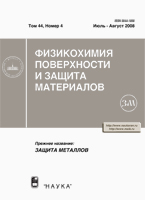The Effect of Ozone on the Corrosion of Steels in the Processes of Oxidation of Pyridines
G. O. Tatarchenko and I. N. Shapovalova
Severodonetsk Technological Institute of the East-Ukrainian National University,
Prospect Sovetskii 59a, Severodonetsk, Luganskaya Oblast, 93400 Ukraine
e-mail:
Этот e-mail защищен от спам-ботов. Для его просмотра в вашем браузере должна быть включена поддержка Java-script
Received November 14, 2003
Abstract — The corrosion-electrochemical behavior of austenitic and ferritic steels and their weld joints in model systems of oxidation of pyridines in the presence of ozone is investigated. Possibilities of applying structural steels to the implementation of organic synthesis processes in ozonated acetic acid media are assessed.

